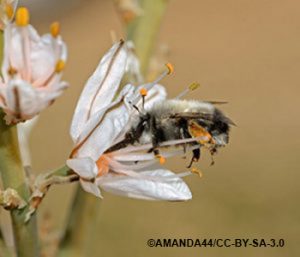Digger Bees
Biology
These are solitary bees though many nest within large colonies. Adults are queens or males. Their nests are found in the ground usually in the soil or an area of flat ground. They fill each cell with pollen and nectar. Both sexes overwinter in the nests. The digger bee is a large bee (normally up to 3cm). It’s characteristics are very recognizable. They are very hairy, with faces that significantly stick out. Their abdomen can be a metallic blue with smaller wing proportions to their body. The sound they make is an audible high pitch whining.
Feeding Preferences
The digger bee feeds on and visits numerous flowers for both pollen and nectar.
Transmitted Diseases
The digger bee does not transmit human diseases.
Habits
Digger bees nest in large numbers in bare areas found in soil or flat land. Some are important pollinators of agricultural crops. Some members of this species are called sweat bees because they are attracted to perspiring skin.The digger bee are usually just a nuisance, but they can give a sharp mild sting especially when being brushed away. The normal reaction to bee stings is pain for a few minutes followed by swelling at the sting site. Often itching and heat may occur. Quickly removing the stinger is the first step. After stinger is removed, it’s best not to rub the area as this causes the venom to spread. For those people who are allergic to stings an adverse reaction is expected. Be aware when you may presence of a nest. Structural Pest have professionally trained technicians who know what to look for when finding these nests that are within the ground.
Structural Pest Bee Program
David will perform a thorough inspection on both the interior and exterior of your home, finding all the infested areas and identifying which pests you are dealing with. Once identified, David will implement a pest control program that is designed to target the specific pests in your home.

